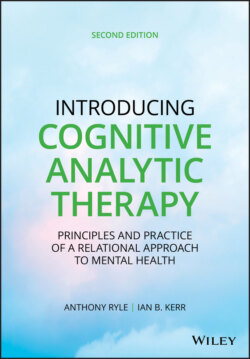Читать книгу Introducing Cognitive Analytic Therapy - Anthony Ryle - Страница 9
Оглавление
List of Figures
| 2.1a | Key formative RR for Bobby. |
| 2.1b | Key RRP enactments. |
| 2.2 | Rating sheet for target problem procedure 1 for Bobby. |
| 3.1a | CAT‐based sketch of normal development of the Self through healthy early infant‐caregiver interactions (RRs) shown here in a ‘nuclear’ family type setting and in a particular sociocultural context. |
| 3.1b | Their subsequent internalisation as formative RRs within the growing child (by permission Bevan Fidler). |
| 4.1 | CAT‐based diagrammatic sketch of damaging and abnormal development of the Self. |
| 6.1 | Part diagrams: sequences illustrating traps, dilemmas, and snags. |
| 6.2 | Types of cores in sequential diagrams. |
| 6.3 | (a–c) Beatrice—Self states sequential diagram. (a) Initial depiction of formative reciprocal roles. (b) Mapping of key reciprocal role procedures leading to a similar state of “deep sadness.” One of these involves enactment of a situational RR of ideally loved to ideally loving (c) mapping the outcome of key reciprocal role procedures which reinforce original formative RRs and depicting also two Self states (SS 1 and SS 2) and highlighting a key dialogic voice using an asterisk. |
| 6.4 | (a) Depicts formative reciprocal roles; (b) mapping of most common coping procedure (effectively a “trap”); (c) further mapping of a “dilemma” leading to a briefly enacted RRP (effectively a “snag”) undermined by a critical voice; (d) depicting possible further RRP enactments (from the parental/culturally‐derived pole of his formative RR) toward Self and/or others. |
| 7.1 | Self states sequential diagram for Rita showing reciprocal roles. B, D, and F represent childhood‐derived roles which, when activated by experiences, perceptions, or memories of A, C, or E, lead to flashpoint X followed by either rage or the dissociated alternative coping zombie state. The consequences of these would be typically “rejection” and having “needs unmet” which in turn would reinforce underlying formative RRs. |
| 8.1 | Sequential diagram for Grace. |
| 9.1 | Simplified SDR/map for Susan showing key formative RR and key RRPs. |
| 9.2 | SDR or “map” for Tamara. |
| 9.3 | SDR/map for Alan. |
| 9.4 | (a) Key formative RRs for Sarah. (b) SDR/map for Sarah. |
| 9.5 | The client in the sessions. |
| 9.6 | The therapist in the sessions. |
| 9.7 | A problematic sequence (RRP) of thoughts, emotions, and behaviors (a “trap”). |
| 10.1 | (a–d) Stages in construction of a stereotypical BPD‐type diagram. (c) illustrates likely dissociated Self states and (d) introduces a description of typical staff reactions around such patients and illustrates a rudimentary “contextual reformulation” (see Chapter 11). |
| 10.2a | Deborah—grid of self‐descriptions. |
| 10.2b | Deborah—grid of self–other relationships. |
| 10.3 | Narcissistic personality disorder: the two common Self states. |
| 10.4 | (a–c) Stages in constructing a stereotypic NPD‐type diagram showing (a) underlying (formative) RRs, (b) typical initial coping RRPs and typical Self states, and (c) potential Self states, defensive RRPs and (situational) RR enactments, including potentially with staff and others. |
| 10.5 | Olivia—sequential diagram (revised and simplified). |
| 10.6 | Sam—final Self state sequential diagram (revised and simplified). |
| 11.1a | Schematic patient SDR or map showing (formative) RRs and consequent RRPs. |
| 11.1b | Schematic rudimentary contextual reformulation showing patient SDR or map and outline possible therapist and staff team (situational) RR enactments toward patient RRPs. Some of these staff RR enactments may be derived in part from their own formative RRs. |
| 11.1c | Schematic extended contextual reformulation showing added layers (like “onion skins”) of interactions arising from possible service context and broader social and political context. |
| 11.2a | Initial description of patient’s formative RRs. |
| 11.2b | Simple contextual reformulation showing patient RRPs and staff team reciprocal (situational) RR enactments and the split between these. Some of these enactments may have partial origins in formative RRs of staff. |
| 11.3a | Initial SDR or map for Paula showing her formative RRs. |
| 11.3b | Initial SDR or map showing subsequent RRPs and consequences. |
| 11.3c | Initial SDR or map showing additional tendencies to dissociate or “fragment” into at least two Self states (broken ellipses). |
| 11.3d | Contextual reformulation showing (situational) reciprocal role interactions between staff and patient with subsequent splits within staff team. Some of these situational enactments may have partial origins in staff formative RRs. |
